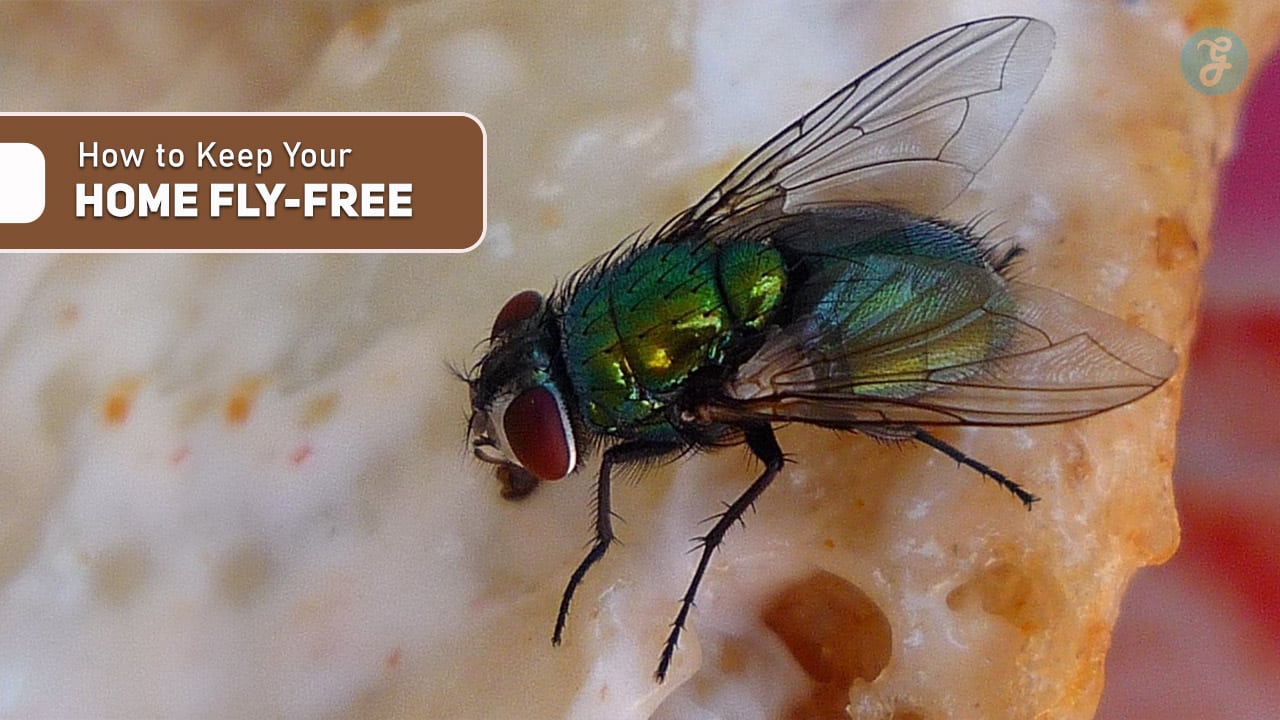Flies are more than just a nuisance; they can be a serious health hazard in your home. These pesky insects are known to spread over 65 diseases to humans, including typhoid fever, cholera, and salmonella. They contaminate food and surfaces with bacteria from their legs and mouth parts, making fly control an essential part of maintaining a clean and healthy living environment.
But fear not! With the right knowledge and techniques, you can significantly reduce or even eliminate fly problems in your home. This comprehensive guide will walk you through 10 effective methods on how to keep your home fly-free. From simple preventive measures to more advanced solutions, we’ve got you covered.
Let’s dive into each of these techniques to help you create a fly-free sanctuary in your home.
1. Seal Entry Points
The first line of defense against flies is to prevent them from entering your house in the first place. Flies can squeeze through incredibly small openings, so it’s crucial to identify and seal potential entry points.
Inspect and Repair
Start by thoroughly inspecting the exterior of your home:
- Cracks in walls or foundations
- Gaps around windows and doors
- Openings around pipes and utility lines
- Weatherstripping is damaged or missing.
Once you’ve identified these potential entry points, seal them using appropriate materials:
- Use caulk for small cracks and gaps.
- Apply weatherstripping around doors and windows.
- Install door sweeps on exterior doors.
- Use steel wool to fill larger gaps, especially around pipes.
Focus on Common Entry Areas
Pay special attention to areas where flies commonly enter:
- Kitchen and bathroom windows
- Doors, including garage doors, lead to the exterior.
- Install mesh covers on vents and chimneys if necessary.
- Areas around air conditioning units
Regular Maintenance
Make it a habit to inspect your home’s exterior regularly, especially after severe weather events that might create new openings. Prompt repairs will help maintain your home’s defense against flies.
By effectively sealing entry points, you can significantly reduce the number of flies that make it into your home. This proactive approach forms the foundation of a comprehensive fly control strategy.
2. Use Proper Food Storage
Food sources attract flies, so it’s important to store food properly to keep them away. By denying flies access to food, you remove one of their primary reasons for entering your home.
Airtight Containers
Invest in a set of high-quality, airtight food storage containers. Use these for:
- Dry goods such as flour, sugar, and cereals are available.
- Fruits and vegetables that don’t require refrigeration are available.
- Leftovers (even in the refrigerator)
Airtight containers not only keep flies out but also help preserve food freshness for longer periods.
Refrigerate Promptly
Don’t leave perishable foods out on counters or tables. Refrigerate them promptly, especially in warmer weather when flies are more active. This includes:
- Meat and dairy products
- Cut fruits and vegetables
- Cooked foods and leftovers
As a general rule, don’t leave perishable foods at room temperature for more than two hours (or one hour if the temperature is above 90°F/32°C).
Cover Food
When preparing meals or during outdoor gatherings:
- For dishes that are temporary, use mesh food covers.
- Keep outdoor food in coolers or covered containers.
- After meals, clean up and store food immediately.
Manage Pet Food
Don’t forget about pet food, which can also attract flies:
- Feed pets at scheduled times, and remove uneaten food after meals.
- Store dry pet food in airtight containers.
- Regularly clean the pet food bowls.
Fruit Bowl Management
If you keep a fruit bowl on your counter:
- Check for overripe or damaged fruit on a daily basis.
- Immediately remove any fruit that shows signs of decay.
- Consider keeping fruit in the refrigerator during peak fly seasons.seasons.seasons.seasons.
Implementing these food storage practices will not only deter flies but also maintain a cleaner, more hygienic kitchen environment. Remember, flies are opportunistic feeders, so eliminating readily available food sources is a powerful deterrent.
3. Maintain clean surfaces
Food residues and organic matter attract flies, so maintaining clean surfaces throughout your home is critical for effective fly prevention. A clean home is less attractive to flies and provides fewer breeding grounds for these pests.
Kitchen Cleanliness
In a home, the kitchen is often the heart of fly activity. Pay special attention to:
- You should thoroughly clean countertops after each use, especially after preparing meals.
- Stovetop: Immediately clean spills and perform a thorough cleaning routine.
- Sink: Don’t let dirty dishes pile up; clean and dry the sink after use.
- Floor: Sweep and mop regularly, paying attention to corners and under appliances
Regular Cleaning Schedule
Establish a regular cleaning schedule for your entire home.
- Make sure to vacuum the carpets and upholstery at least once a week.
- Dust surfaces regularly to eliminate any organic matter that might attract flies.
- Mop concrete floors with a disinfectant solution.
Focus on Organic Matter
Pay special attention to areas where organic matter might accumulate:
- Empty and clean trash cans regularly.
- Wipe down trash can lids and surrounding areas.
- Clean up pet accidents immediately.
- Address any moisture issues that might lead to mold growth.
Clean Hidden Areas
Don’t forget about less visible areas:
- Behind and under large appliances
- Inside and around drains
- Window sills and door frames
Use appropriate, appropriate learning products
Choose cleaning products that not only clean but also disinfect:
- Look for products that kill 99.9% of germs and bacteria. bacteria.bacteria.bacteria.
- Consider using natural alternatives like vinegar and baking soda for everyday cleaning.
- For tough jobs, use a mixture of hot water and dish soap. soap.soap.soap.
Immediate Spill Clean-up
Act quickly when spills occur:
- Clean up food and drink spills immediately. immediately.immediately.
- Pay special attention to sugary substances, which are particularly attractive to flies.
Drain Maintenance
Keep drains clean and free-flowing…
- Regularly remove buildup with a drain brush.
- To help dissolve organic matter, pour boiling water down drains on a weekly basis.
- To break down organic residues, consider using enzymatic drain cleaners on a monthly basis.
By maintaining clean surfaces throughout your home, you create an environment that’s far less attractive to flies. This proactive approach to cleanliness not only helps with fly control, but also contributes to overall home hygiene and health.
4. Install and maintain screens
Screens are a simple yet highly effective barrier against flies and other insects. Properly installed and maintained screens allow you to enjoy fresh air without worrying about fly intrusion.
Install screens on all openings
Make sure to address all possible points of entry.
- Windows
- Doors (including sliding glass doors)
- Attic vents
- Chimney openings
Choose the Right Mesh Size
When it comes to fly prevention, not all screens are equal.
- Standard window screens (with 16×16 or 18×16 mesh) are sufficient for most flies.
- For smaller insects like gnats or no-see-ums, consider finer mesh (20×20 or higher).
Proper Installation
Ensure screens are installed correctly:
- Use appropriate frame sizes for each opening.
- To prevent gaps, tightly secure screens.
- Consider professional installation for large or complex openings.
Regular Inspection and Maintenance
Screens can become damaged over time.
- Inspect screens regularly for holes, tears, or gaps.
- Look for signs of wear around the edges where the screen meets the frame.
- Ensure that the screens remain securely fastened within their frames.
Prompt Repairs
Address any damage promptly:
- Screen repair kits, available at most hardware stores, can patch small holes.
- For larger damages, consider replacing the entire screen.
- Damaged frames may require a complete replacement.
Seasonal Considerations
Typically, people in colder climates remove their screens for the winter.
- Clean screens thoroughly before storage.
- Store screens in a dry place to prevent mold and mildew.
- Inspect and repair screens before reinstalling in spring.
Screen Doors
Pay special attention to screen doors:
- Ensure the door closes tightly and automatically with a spring mechanism.
- Check that the screen door latch works properly.
- Consider installing a door sweep at the bottom to prevent gaps.
Alternative Options
For situations where traditional screens aren’t practical:
- Consider retractable screens for large openings or patio areas.
- Magnetic screens should be used on doors that receive a lot of traffic.
Clean screen screens regularly
Keeping screens clean improves their effectiveness and longevity.
- To remove dust and debris, gently vacuum screens. debris.
- For more thorough cleaning, remove screens and wash with mild soap and water. water.
- Allow screens to dry completely before reinstalling. reinstalling.
Installing and properly maintaining screens creates a physical barrier that significantly reduces the number of flies entering your home. This method allows you to enjoy fresh air and natural ventilation without compromising on pest control.
5. Utilize Natural Repellents
Natural repellents offer an eco-friendly and often pleasant-smelling alternative to chemical pesticides. These solutions can be particularly appealing if you have children or pets, or if you’re simply looking for a more natural approach to fly control.
Essential Oils
Many essential oils have insect-repelling properties:
- Peppermint oil
- Lavender oil
- Eucalyptus oil
- Lemongrass oil
- Tea tree oil
How to use:
- Mix 10-15 drops of essential oil with water in a spray bottle. bottle.
- Spray around windows, doors, and other potential entry points. points.
- Apply a fresh coat every few days or after a rainfall. rain.
Herbs and Plants
Certain plants naturally repel flies:
- Basil
- Mint
- Lavender
- Marigolds
- Chrysanthemums
Consider:
- Plant these near entry points in your garden.
- Place potted versions of these plants on windowsills or near doors.
- Hang dried bunches of herbs in your kitchen or other problematic areas.
Vinegar Solutions
Vinegar can be an effective fly deterrent.
- Mix equal parts water and apple cider vinegar. vinegar.
- Add a few drops of dish soap to break surface tension. tension.
- Place this mixture in small bowls around your home. home.
Citrus Peels
Flies dislike the smell of citrus.
- Rub citrus peels on windowsills and door frames. frames.
- Place bowls of citrus peels in areas where flies are prevalent.common.
- Use a citrus-based cleaner for your regular cleaning routine. routine.
DIY Fly Paper
Make your own natural flypaper.
- Mix 1/4 cup corn syrup, 1 tablespoon granulated sugar, and 1 tablespoon brown sugar
- Spread on strips of brown paper or cardboard. cardboard.
- Hang in problem areas.
Clove-Studded Fruit
This old-fashioned method can be surprisingly effective:
- Stud an apple or lemon with whole cloves. cloves.
- Place these in areas where flies are problematic.problematic.
- Replace the fruit every few days as it starts to dry out. out.
Natural Outdoor Solutions
For your yard and outdoor spaces:
- Plant fly-repelling herbs and flowers in your garden.
- Use citronella candles or torches during outdoor gatherings. gatherings.
- Consider installing a fan on your porch or patio, as flies have difficulty flying in breezes.
Considerations When Using Natural Repellents
While natural repellents are generally safe, keep in mind:
- Some essential oils can be harmful to pets, particularly cats.
- Natural doesn’t always mean non-toxic; use caution around children and pets.
- Some people may be sensitive to certain plant odors or essential oils.
- Reapplying natural repellents more frequently than chemical alternatives may be necessary.
By incorporating these natural repellents into your fly control strategy, you can create a more pleasant and eco-friendly environment while still effectively deterring flies. Experiment with different methods to find the combination that works best for your home and preferences.
6. Set Up Fly Traps
Fly traps can be an effective way to reduce fly populations in your home. They work by attracting flies with bait and then trapping them, preventing them from reproducing and spreading. There are various types of fly traps available, from commercial options to DIY solutions.
Commercial Fly Traps
Many ready-made fly traps are available on the market:
- Disposable bag traps: They hang outdoors and contain attractants.
- Indoor fly light traps: Use UV light to attract flies to a sticky surface.
- Fly bottles, designed for outdoor use, contain liquid attractants.
Pros of commercial traps:
- Convenient and ready to use
- Often more durable than homemade options
- May contain professionally formulated attractants
Cons:
- They can be more expensive than DIY solutions.
- It might include substances you’d like to steer clear of.
DIY Fly Traps
With common household items, you can make effective fly traps at home.
- Vinegar and dish soap trap
- Fill a jar halfway with apple cider vinegar.
- Add a few drops of dish soap.
- Cover with plastic wrap and poke small holes.
- Milk, Sugar, and Pepper Trap
- Mix 1 cup of milk, 1/4 cup of sugar, and 2 tablespoons of ground pepper
- Simmer for 10 minutes and pour into a shallow dish.
- Wine Bottle Trap
- Leave a small amount of sweet wine in a bottle.
- Place it in problem areas.
Pros of DIY traps:
- Cost-effective
- Use natural ingredients you likely have on hand.
- Can be easily customized and replaced
Cons:
- May be less durable than commercial options
- Might require more frequent maintenance
Placement of Fly Traps
Strategic placement is key to the effectiveness of fly traps.
- Place traps near entry points, such as windows and doors.
- Place traps where you frequently see flies.
- For outdoor traps, position them away from seating areas and entrances to your home.
- In the kitchen, keep traps away from food preparation areas.
Maintenance of Fly Traps
Regular maintenance ensures traps remain effective.
- Check traps daily, especially when you first set them up.
- Empty and clean reusable traps regularly.
- According to the manufacturer’s instructions, replace disposable traps.
- Refresh DIY trap solutions every few days.
Combining Trap Types
For maximum effectiveness, consider using a combination of trap types:
- Use sticky traps or fly paper for instant results.
- For long-term control, set up bait traps.
- Place UV light traps in areas where flies are particularly problematic.
Safety Considerations
When using fly traps:
- Keep traps away from children and pets.
- Be cautious with liquid traps that could spill
- If using outdoor traps, ensure they won’t attract beneficial insects.
Seasonal Adjustments
Adjust your trapping strategy based on the season:
- Increase the number of traps during the warmer months, when fly activity is higher.
- In cooler seasons, focus on indoor traps near heat sources where flies may congregate.
By incorporating fly traps into your overall fly control strategy, you can significantly reduce the fly population in and around your home. Remember, traps work best as part of a comprehensive approach that includes prevention and other control methods.
7. Employ fly paper and sticky traps
Flypaper and sticky traps are simple yet effective tools for controlling fly populations in your home. These methods work by trapping flies on an adhesive surface, preventing them from breeding and spreading.
Types of sticky traps
There are several varieties of sticky traps available:
- Traditional Fly Paper
- A sticky substance coated the long strips.
- Often infused with attractants
- Window Fly Traps
- Stickers, whether clear or decorative, adhere to windows.
- When applied correctly, it’s nearly invisible.
- Sticky Boards
- Flat, rigid boards coated with adhesive
- You can place it on surfaces or hang it
- Decorative sticky traps
- Designed to be less visually obtrusive
- Come in various shapes, like flowers or butterflies.
How to Use Fly Paper and Sticky Traps?
When used properly, these traps become more effective.
-
Placement
- Hang or position traps near windows, doors, and light fixtures.
- Place traps in areas where you frequently see flies observed.
- For kitchens, place near (but not directly above) food preparation areas.
- In outdoor areas, hang traps away from seating areas.
- Installation
- For hanging traps, use the provided hooks or strings.
- Apply window traps smoothly to prevent air bubbles.bbles.bubbles.
- Place sticky boards on flat surfaces, or use the provided hangers.vided hangers.hangers.hangers.
- Quantity
- For larger spaces or severe infestations, use multiple traps.festations.infestations.
- In problem areas, one trap per window is a good rule of thumb….
Advantages of Fly Paper and Sticky Traps
These simple devices offer several benefits:
- Inexpensive and widely available
- No harmful chemicals or odors
- Silent operation
- Effective for continuous, passive fly control
- This can help monitor the severity of fly problems
Limitations and Considerations
While effective, sticky traps do have some drawbacks:
- Can be visually unappealing
- It has the potential to capture beneficial insects or even small reptiles when used outdoors.tdoors.outdoors.
- They must be replaced on a regular basis as they become full or lose stickiness.ickiness.stickiness.
- It can be messy if they are touched or if they fall.
DIY sticky traps
You can make your own sticky traps:
- Homemade Fly Paper
- Mix equal parts corn syrup, sugar, and water.water.water.
- Soak strips of brown paper or cardboard in the mixture.mixture.mixture.
- Hang to dry, sticky side out.out.out.
- Sticky Bottle Trap
- Cut the top off a plastic bottle.bottle.bottle.
- Coat the exterior with a mixture of sugar and corn syrup.syrup.syrup.
- Place near problem areas
Maintenance and Replacement
To keep sticky traps effective:
- Check traps on a regular basis, at least once a week.ek.week.
- Replace traps when they are about 80% full or lose stickiness.ickiness.stickiness.
- Dispose of used traps in sealed plastic bags.
Combining with Other Methods
Sticky traps work well in combination with other fly control techniques…
- For comprehensive coverage, use baited traps alongside coverage.
- To deter flies from certain areas, supplement with natural repellents.eas.areas.
- For best results, use in conjunction with proper sanitation results.
Environmental Considerations
When using sticky traps, especially outdoors:
- Avoid placing them in areas where birds or beneficial insects are active.
- Consider using catch-and-release traps for outdoor spaces to avoid harming beneficial species.species.species.
- Opt for traps without added chemical attractants if you’re concerned about environmental impact.
By effectively employing fly paper and sticky traps, you can significantly reduce the fly population in your home. Remember, these traps are most effective when used as part of a comprehensive fly control strategy that includes prevention, sanitation, and other control methods.
8. Use insect light traps
Insect light traps, also known as bug zappers or UV light traps, are electronic devices that attract and eliminate flying insects, including flies. They work by luring insects with ultraviolet light, then trapping or electrocuting them.
Types of insect light traps
There are several varieties available:
- Electric Grid Zappers
- Attract insects with UV light.
- Electrocute insects that come into contact with an electric grid
- Glueboard Light Traps
- To attract insects, use UV light.
- On a sticky glue board, capture insects.ard.board.
- Fan-based Traps
- Attract insects with UV light.
- Use a fan to pull insects into a collection chamber.chamber.chamber.
- Decorative Light Traps
- Designed to be more aesthetically pleasing
- UV light is often combined with other attractive features….
How to insect light traps work?
Understanding the mechanism can help you use these traps more effectively…
- UV light mimics the wavelengths that attract many flying insects.insects.insects.
- The light source attracts insects… source.
- The next steps involve electrocuting, sticking insects to a glue board, or sucking them into a chamber, depending on the type.amber.chamber.
Proper Placement of Light Traps
Location is crucial for maximizing effectiveness…
- Place traps 4-6 feet off the ground.ground.ground.
- To avoid attracting outdoor insects, position away from windows and doors… insects.
- In commercial kitchens, place traps at least 5 feet away from food preparation areas.
- For outdoor use, place traps 15-20 feet away from guest areas.
Advantages of Insect Light Traps
These devices offer several benefits:
- Continuous, 24/7 protection
- We do not use any chemical pesticides. Sticides are used.
- It has the ability to capture a variety of flying insects.
- Some models aim to be visually unobtrusive.obtrusive.unobtrusive.
- Effective in both residential and commercial settings
Limitations and Considerations
While useful, light traps do have some drawbacks:
- This type of trap may cost more than others.
- To operate, electricity is required.
- May attract beneficial insects, as well as pests….
- Some models can be noisy (especially “zapper” types).
- UV bulbs need periodic replacement.
Maintenance of Light Traps
Regular upkeep ensures optimal performance:
- Clean the trap regularly, following manufacturer instructions.
- Replace UV bulbs annually or as recommended.
- For glueboard models, replace the sticky board as needed.
- Fan-based models frequently have empty collection trays.
Energy Efficiency
Evaluate the energy consumption of these devices:
- Look for Energy Star-certified models.
- Use timers to only operate traps during peak insect activity hours….
- Consider solar-powered options for outdoor use.
Safety Considerations
When using insect light traps:
- Keep out of the reach of children and pets.ts.pets.
- Make sure the device is suitable for outdoor use… conditions.
- Follow the manufacturer’s guidelines for safe operation and cleaning.
Combining with Other Methods
Light traps can complement other fly control techniques:
- Use in conjunction with proper sanitation procedures.
- Add fly screens to windows and doors.ors.doors.
- Add natural repellents to specific areas.
Environmental Impact
Be mindful of the broader effects of these traps.
- Avoid using in ecologically sensitive areas.areas.areas.
- To minimize harm to beneficial insects, consider using glueboard or fan-based traps instead of zappers.
- If using outdoors, position away from areas frequented by bats or nocturnal pollinators.pollinators.pollinators.
Insect light traps can be a valuable tool in your fly control arsenal, especially in areas where flies are a persistent problem. By understanding how they work and using them correctly, you can significantly reduce fly populations in your home or business while minimizing negative impacts on beneficial insects and the environment.
9. Practice proper management
Effective waste management is crucial in preventing fly infestations. Organic waste attracts flies and serves as a breeding ground for them. By properly managing your waste, you can significantly reduce the fly population around your home.
Secure garbage containers containers
Start with proper garbage containment:
- Use garbage cans with tight-fitting lids…
- Make sure the containers are free from any cracks or holes.
- Consider using bungee cords to secure the lids of outdoor bins.
- Line garbage cans with plastic bags for easy cleaning.
Regular rubbish disposal disposal
In waste management, frequency is important.
- Make sure to regularly empty the indoor garbage cans, particularly those in the kitchen.itchen.
- Place your outdoor garbage at the curb either weekly or according to the local collection schedules.chedules.
- During the warmer months, it is advisable to consider more frequent disposal to prevent fly breeding.reeding.
Clean garbage containers
Keep garbage receptacles clean.
- After emptying containers, rinse them.
- Periodically wash with soap and water or a diluted bleach solution.
- Allow the containers to dry completely before reuse.
- Sprinkle baking soda in the bottom of clean bins to absorb.
Composting Best Practices
If you compost, make sure to do it correctly to prevent attracting flies.
- Use a compost bin with a tight-fitting lid.id.
- Layer “green” (nitrogen-rich) and “brown” (carbon-rich) materials properly.
- Turn the compost regularly to promote decomposition.
- Avoid adding meat, dairy, or oily foods to the compost.
Manage pet waste
Pet waste can be a significant attractant for flies.
- Every day, clean up the pet droppings in the yard.
- Use sealed bags for the disposal of pet waste.
- Consider using an underground pet waste digester for eco-friendly disposal.
Food Scrap Management
Handle food scraps with care..
- Freeze smelly food scraps until garbage day.
- Use a sealed countertop compost bin for temporary storage.
- Rinse food containers before placing them in the recycling bin.
Yard Waste Considerations
Don’t forget about outdoor organic matter:
- Rake the leaves and dispose of them promptly.romptly.
- Clear the fallen fruits from the trees in your yard.ard.
- Avoid leaving grass clippings on the lawn after mowing.
Proper storage of recyclables
Recyclables can attract flies if not managed properly.
- Rinse all recyclable containers before storage.
- Use a covered bin for outdoor recycling storage.
- Sort recyclables regularly to prevent buildup.
Commercial Considerations
For businesses, especially in food service:
- Use dumpsters with tight-fitting lids
- Schedule frequent waste pickup, especially in warm weather.
- Implement a cleaning schedule for waste storage areas.
- Train staff on proper waste management procedures.
Liquid Waste Management
Don’t overlook liquid waste.
- Avoid pouring liquids into garbage bags.
- For suitable liquid waste, use sink disposal or composting.
- For outdoor events, provide separate containers for liquid waste.
Community Efforts
Encourage community-wide waste management:
- Participate in or organize community clean-up events
- Report overflowing public garbage bins to local authorities.
- Educate neighbors about the importance of proper waste management in fly control.
Implementing these waste management practices creates an environment that is far less attractive to flies. Remember, eliminating breeding sites is one of the most effective long-term strategies for fly control. Proper waste management not only helps control flies but also contributes to a cleaner, more hygienic living environment overall.
10. Consider professional pest control
While you can implement many fly control methods on your own, there are situations where professional pest control services may be necessary. Professional exterminators have access to more potent treatments and can provide comprehensive solutions for persistent or severe fly problems.
When to Consider Professional Help?
Consider calling in the experts if:
- DIY methods have been ineffective.
- You have a large or persistent fly infestation.
- You’re dealing with multiple types of pests
- There’s a risk of property damage or health hazards.
- You lack the time or ability to implement comprehensive fly control measures.
Types of Professional Fly Control Services
Pest control professionals offer various treatment options:
- Chemical Treatments
- Insecticides are applied in targeted areas.
- Growth regulators are used to disrupt the life cycles of flies.
- Baiting Systems
- Professional-grade fly baits and traps
- Strategically placed for maximum effectiveness.
- Exclusion Methods
- Identifying and sealing entry points
- Installing professional-grade screens and barriers
- Sanitation Consultations
- We are seeking advice on improving waste management and sanitation practices.
- Identifying potential breeding sites
- Integrated Pest Management (IPM)
- A comprehensive approach to combining multiple control methods
- Customized to suit your unique situation and environment
Benefits of Professional Pest Control
Hiring experts can offer several advantages:
- More potent and regulated pesticides are accessible.
- Expertise in identifying specific fly species and appropriate treatments.
- Homeowners or businesses can save time.
- Long-term solutions rather than quick fixes
- Regular monitoring and follow-up treatments are necessary.
What to Expect from a Professional Service?
A typical professional fly control service may include the following:
- Inspection: Conduct a thorough examination of your property to identify fly species, entry points, and breeding sites.
- Treatment Plan: Create a customized strategy based on the inspection findings.
- Initial Treatment: Applying appropriate control methods.
- Follow-up: Subsequent visits to assess effectiveness and apply additional treatments if needed.
- Prevention Advice: recommendations for ongoing prevention measures.
Choosing a Pest Control Professional
When selecting a service:
- Look for licensed and certified professionals.
- Check reviews and ask for references.
- Ensure they use EPA-approved products and methods.
- Ask about their approach to IPM and eco-friendly options.
- Get detailed quotes and treatment plans from multiple providers.
Preparing for professional treatment
Before the pest control visit:
- Remove clutter to allow access to all areas.
- Secure pets and cover fish tanks.
- Follow any pretreatment instructions provided by the company.
After Professional Treatment
To maximize effectiveness:
- Follow all post-treatment instructions carefully.
- Implement recommended prevention measures.
- Monitor for any resurgence of fly activity.
- Maintain communication with the pest control company.
Combining Professional and DIY Methods
For optimal results:
- Continue with basic sanitation and prevention measures.
- Use professional treatments to achieve targeted, powerful control.
- Implement expert recommendations for long-term management.
Environmental and Health Considerations
When opting for professional services:
- With the pest control company, discuss any health concerns or sensibilities.
- Ask about eco-friendly or low-toxicity treatment options.
- Ensure proper ventilation after chemical treatments.
- Follow safety guidelines regarding re-entry times after treatment.
Cost Considerations
Professional pest control can be an investment.
- Compare the cost to the potential damage or health risks of an untreated infestation.
- Consider long-term savings from effective, professional treatment.
- Ask about service guarantees or ongoing maintenance plans.
While DIY methods can be effective for minor fly problems, professional pest control services offer a higher level of expertise and more powerful tools for severe or persistent infestations. Combining professional services with ongoing prevention measures, you can achieve comprehensive, long-lasting fly control in your home or business.
Conclusion
Keeping your home fly-free is an ongoing process that requires a combination of prevention, intervention, and maintenance. By implementing the ten techniques we’ve discussed—sealing entry points, proper food storage, maintaining clean surfaces, installing and maintaining screens, utilizing natural repellents, setting up fly traps, employing fly paper and sticky traps, using insect light traps, practicing proper waste management, and considering professional pest control when necessary—you can significantly reduce or eliminate fly problems in your living space.
Remember, the key to effective fly control is consistency and a multi-faceted approach. No single method is likely to solve all your fly problems, but a combination of these techniques can create an environment that is inhospitable to flies and other pests.






































